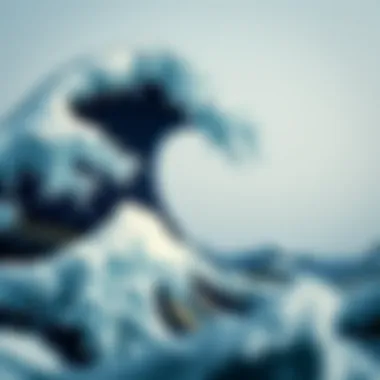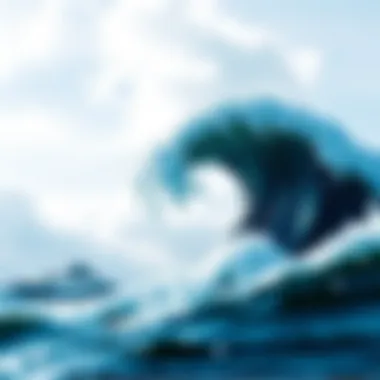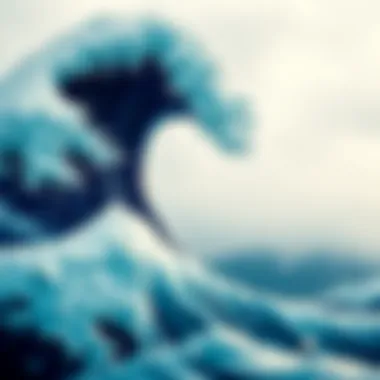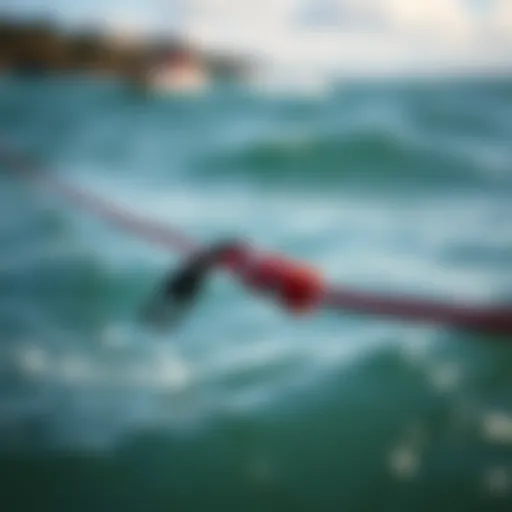A Comprehensive Look at Hokusai's Great Wave


Intro
Katsushika Hokusai's woodblock print, famously known as "The Great Wave Off Kanagawa," is a masterpiece that has captured the imagination of artists, historians, and surfers alike. Created during the Edo period, this iconic piece has transcended time, resonating far beyond its original medium. As both a powerful representation of nature and a commentary on humanity's place within it, this artwork serves as a focal point for discussions that blend art, culture, and even modern watersports.
In this exploration, we aim to peel back the layers of Hokusai's work, examining the historical context in which it was created, the intricate techniques he employed, and the print's enduring impact on contemporary culture. The intersection of nature and man, so vividly portrayed in this piece, prompts reflections that extend into the realms of water sports and environmental stewardship, making it a fertile ground for deeper understanding.
To embark on this journey, we will first delve into essential gear that connects enthusiasts of water sports with the essence of this iconic wave, before maneuvering through tips and techniques that reflect Hokusai’s mastery in composition and execution. It's not just a wave; it's a movement, and its ripples are felt across generations.
Historical Context of The Great Wave
Understanding the historical context surrounding The Great Wave Off Kanagawa is crucial to appreciating not only Hokusai’s artistry but also the socio-cultural fabric of the Edo Period in Japan. This time frame, lasting from the early 17th century until the mid-19th century, was marked by significant cultural, economic, and technological transformations. By exploring this context, readers can glean insights into how Hokusai’s work is interwoven with the life, values, and struggles of the time.
The Edo Period and its Influence
The Edo Period, also known as the Tokugawa Period, ushered in a relative peace and stability after centuries of conflict in Japan. This era fostered a flourishing of the arts, craftsmanship, and commerce. The rise of a merchant class, known as the chōnin, in cities like Edo (now Tokyo), Osaka, and Kyoto allowed for greater access to art and literature, moving it from the exclusive hands of the samurai and aristocrats.
During this period, the appreciation of visual arts, particularly ukiyo-e—woodblock prints that depicted landscapes, kabuki actors, and beautiful women—saw a dramatic upswing. Hokusai, as a prominent figure in this movement, utilized his artworks to portray not just aesthetic beauty, but also the powerful interplay between humanity and nature. In The Great Wave, we see the manifestation of a strong cultural belief that acknowledged nature’s might. The tidal wave becomes a metaphor for the uncontrollable forces of nature that were revered and feared alike.
Notably, the prints were broadly accessible due to the innovative woodblock printing techniques. Hokusai himself was known to experiment continuously, pushing the boundaries of traditional techniques and introducing new ones, blending styles from both Japanese and Western sources which had begun to trickle into Japan through trade.
Hokusai's Early Life and Career
Born in 1760 in Edo, Katsushika Hokusai was immersed in the artistic fervor of the Edo culture from an early age. His formative years were marked by economic hardship, which became a motivating factor for his creative pursuits. Hokusai started his career as an apprentice in a traditional painting studio but soon became disenchanted with the confines of that style, opting to venture out on his own to find unique expression.
His early works were steeped in the aesthetics of traditional landscapes; however, Hokusai’s passion for the sea and nature began to develop in earnest as he aged. This personal connection to water can be seen reflected in the rhythmic, almost violent motion of the waves in The Great Wave Off Kanagawa. His experiences as a woodblock print artist allowed him to experiment with color and form, leading to the powerful representation synonymous with this iconic piece today.
Hokusai's vision of capturing the essence of nature's enormity foreshadowed an artistic legacy that would reach across generations and cultures. He once famously said, "From the age of six, I had a desire to draw the forms of things. From the age of fifty, I have been in the habit of sketching all kinds of things. And it is at seventy-three that I have come to understand the underlying principles of things in nature."
This quote encapsulates his relentless pursuit of artistic expression and understanding, mirroring the tumultuous yet beautifully harmonious nature depicted in his works. Hokusai's journey reflects not only the evolution of an artist but also the cultural waves of an entire era, establishing a significant link between the personal and societal influences of the time.
Artistic Techniques Employed by Hokusai
Understanding the artistic techniques employed by Hokusai is crucial to appreciating the depth of The Great Wave Off Kanagawa. His mastery in the woodblock printing process, combined with meticulous color choices, creates a visual language that speaks volumes about nature and humanity's interaction with it. Each technique not only adds aesthetic value but also layers of meaning to the artwork that resonate with viewers across generations.
Woodblock Printing Process
Overview of Woodblock Printing
Woodblock printing, or ukiyo-e, brought forth a revolution in the art world during Hokusai's time. This technique allowed for the mass production of art, making it accessible to a wider audience. The key characteristic of woodblock printing lies in its ability to reproduce intricate designs while preserving hand-crafted nuances. This blend of craftsmanship with reproducibility is both beneficial and popular for enthusiasts and historians alike. One unique feature is the collaboration between different artisans in the process, where a skilled carver, printer, and designer bring forth a single piece.
Materials Used
Hokusai's choice of materials significantly influenced the quality and effect of The Great Wave. Traditionally, a variety of materials were deployed, including hand-made paper and natural pigments. The key characteristic of these materials is their durability and capability to hold vibrant colors. This decision made the prints not just visually striking but also long-lasting. One unique aspect of the paper used is that it was often derived from the mulberry tree, providing a texture that enhances color absorption, thereby elevating the print's overall effect. Yet, the use of such specific materials also comes with its disadvantages, like limited availability, which could impact accessibility for modern reproductions.
Step-by-Step Process


The step-by-step procedure of woodblock printing elucidates the dedication behind Hokusai’s work. The key characteristic here is the layered approach, typically beginning with sketching the design onto a wood block. The printmaker will carve the design into the block, removing those areas that should remain white. Each color requires a separate block, demanding precision and coordination. One unique feature of this process is the hand-application of ink, a technique ensuring that each print maintains a level of individuality, shaped by the nuances inherent in human touch. However, this also means that achieving consistency can be challenging, presenting another layer of complexity to the art form.
Color Choices and Their Symbolism
Hokusai's choices in color serve as a visual melody that complements the tumultuous scene of the wave. He juxtaposes deep blues, whites, and muted earth tones, echoing the elemental struggle between man and nature. The symbolism embedded in these hues transcends mere aesthetics; the vibrant blues suggest both power and tranquility, connoting the relentless force of the sea against the fragile human experience. It’s this duality that invites viewers to reflect on their place within the natural world and understand deeper themes such as vulnerability and resilience. In an age where environmental awareness is paramount, revisiting Hokusai's palette becomes an essential part of recognizing our ongoing relationship with nature.
Hokusai’s The Great Wave Off Kanagawa remains a potent symbol of human endurance in the face of nature's majesty. Its artistic techniques capture not just a moment in time, but a universal narrative that persists across cultures and eras.
By delving into Hokusai's artistic techniques, we uncover the almost tangible connection between the artist's vision and the audience's experience, illuminating why this particular piece continues to inspire. Through understanding these meticulous techniques, we appreciate not just the artistry but also the experiences, stories, and deeply rooted cultural contexts that Hokusai brings to life.
Composition and Elements of The Great Wave
The composition of Hokusai's 'The Great Wave Off Kanagawa' is not just a visual spectacle; it's a masterclass in blending natural forces with human emotion. Understanding the various elements that Hokusai meticulously crafted helps appreciate the significance of this iconic piece. The interplay of colors, shapes, and the tension between human vulnerability and nature's ferocity lie at the crux of its impact.
Wave Dynamics: Form and Motion
The dynamic quality of the wave is striking. Hokusai didn’t just depict a wave; he created a living thing, twisting and churning with ferocity. The wave looms large, almost menacing, and seems to curl back, ready to crash down upon the tiny boats beneath it. This form of motion raises questions about control and chaos.
- Curvature: Notice the sharp angles created by the wave's details, accentuated through negative space and flowing lines. This technique draws the viewer's eye across the print, mimicking the viewer's potential journey through turbulent waters.
- Foam Details: Hokusai's attention to the foam adds texture and depth. Each frothy crest seems almost alive, suggesting the wave's power and relentless energy.
The wave, while incredibly detailed, creates an illusion of movement — it behaves as if it's both in the moment and a moment captured in time, resonating deeply with anyone who has ever faced nature's raw power.
Human Element: The Fishermen's Struggle
In stark contrast to the overwhelming wave are the tiny figures of the fishermen—mere dots battling with nature's might. Hokusai captures a quiet resilience amid chaos; the fishermen's toil reflects a broader human experience. Their struggle is relatable, representing all those who face adversity in both life and sport.
- Scale: Comparing the enormous wave to the small boats underscores humanity's vulnerability. This contrast is essential in understanding the scene's emotional weight.
- Postures: Each fisherman’s pose tells a story. One leans forward, straining against the wind; another pulls at the sails, his effort palpable.
This relationship between the figures and the wave draws out themes of determination and survival, which can be reflected in modern water sports—surfers and athletes on the water experience their own battles with the sea, echoing the fishermen in Hokusai's print.
Mount Fuji: Symbol of Endurance
While the wave dominates the foreground, Mount Fuji stands in the background like an unwavering guardian. Its presence grounds the chaotic scene and symbolizes strength and longevity, adding layers of interpretation.
- Cultural Significance: Mount Fuji has been a revered symbol in Japanese culture for centuries. It represents not just nature but the endurance of tradition amid change.
- Contrast with the Wave: While the wave represents chaos and impermanence, Fuji offers a stark reminder of stability and permanence. The juxtaposition forces the viewer to reflect on the duality of existence; the fleeting nature of life and the immutable landmarks that witness it all.
Hokusai’s choice to include Fuji adds depth to the composition, transforming it into a narrative rather than just a visual representation. The viewer is invited to contemplate their relationship with nature and find their place between vulnerability and strength.
Overall, the intricate composition and elements of 'The Great Wave Off Kanagawa' are what continue to draw people into Hokusai's world, resonating particularly with those in water sports who often find themselves battling their own waves. The print isn't merely an image; it's a reflection of the human spirit against the vast, unpredictable forces of nature.
"Hokusai's wave captures the essence of conflict and peace, reminding us of our place in this vast universe."
For further exploration of this iconic piece of art, visit Britannica or learn more about the cultural impact of Hokusai at Wikipedia.
By understanding the composition intricacies, one can see how Hokusai’s work continues to inspire generations of artists and athletes alike.


Themes in The Great Wave
In Katsushika Hokusai's The Great Wave Off Kanagawa, the themes captured resonate beyond the canvas, presenting a vivid exploration of humanity's relationship with nature. The artwork is not simply a decoration; it serves as a profound commentary on existence, navigating between the ferocity of nature and the innate fragility of human life. This section delves into two principal themes: the unstoppable power of nature versus human vulnerability and the cultural symbolism of the sea. These themes anchor the narrative of the piece and blend art with deeper societal reflections.
Nature's Power vs. Human Vulnerability
One of the most striking contrasts in The Great Wave is the depiction of nature's overwhelming force against the vulnerability of mankind. The wave itself, fierce and monumental, looms ominously over the small fishing boats, representing the vastness and unpredictability of nature. The fishermen, dwarfed by the towering wave, embody human fragility in the face of such majestic power. This theme elicits a multifaceted response, engaging viewers to reflect on their own situations when pitted against nature's whims.
The juxtaposition of man and nature invites contemplation about our environmental impact and the climate challenges that loom. Surfers, paddleboarders, and kitesurfers alike can relate to both the thrill and the danger that comes with engaging with the sea. The artworks messaging acts as a reminder of respect, urging these enthusiasts to embrace the waves while simultaneously recognizing their potential for fury.
"The Great Wave serves as a visual manifesto about the relationship between humans and the environment—one of both admiration and caution."
Cultural Symbolism of the Sea
The sea in Hokusai's masterpiece acts not merely as a background but as a dynamic character in its own right, rich with cultural significance. In Japanese culture, the ocean is often seen as a source of life, beauty, and sustenance, but also as an unpredictable force that can bring destruction. This duality is essential when considering how the sea symbolizes the broader human experience, characterized by both hope and peril.
The positioning of Mount Fuji in the background emphasizes this cultural context. Fuji stands resilient and unwavering—a symbol of endurance amidst the chaos of the tumultuous waves. Such elements reflect the Japanese worldview, which often intertwines natural phenomena with human philosophy. The sea, portrayed as both bountiful and treacherous, connects deeply with the ethos of surfers and other water enthusiasts who revel in its splendor yet must remain ever aware of its volatile nature.
Through this intricate relationship of man, nature, and culture, The Great Wave Off Kanagawa transcends being a mere piece of art; it shapes our perception of the world, urging us to confront the seas with both humility and reverence.
As we navigate through diverse interpretations of Hokusai's work today, it’s vital for us to appreciate the profound insights it offers about the complexities that underpin our activities in the water—whether it's surfing, paddleboarding, or even just enjoying the ocean's beauty. Hokusai’s vision continues to inspire and serve as a compelling allegory to the lives we lead, perpetually influenced by our surroundings.
Cultural Impact and Legacy of The Great Wave
The legacy of The Great Wave Off Kanagawa extends far beyond its initial creation in the early 19th century. This artwork serves not merely as a captivating image but as a cultural touchstone that resonates across multiple realms. Its evocative portrayal of nature's tumultuous power has inspired countless modern artists and has deeply embedded itself in popular culture. For surfers, paddleboarders, and kitesurfers alike, this iconic image encapsulates both the thrill and respect commanded by the sea.
Through its significant cultural impact, The Great Wave has become emblematic of the relationship between humanity and nature. It prompts a deeper understanding of our vulnerabilities while celebrating resilience. This duality—the admiration and fear of nature—reflects in various contemporary expressions ranging from fashion to fine art. Artists today reference or reinterpret Hokusai's wave, fusing the historic and the modern to express their own sentiments regarding the natural world.
"The Great Wave is where art meets nature's fury; it is a reminder that while we seek harmony with the ocean, we must also acknowledge its indomitable spirit."
The Wave in Modern Art and Media
The presence of The Great Wave in modern art and media cannot be understated. Its striking imagery has been adapted in diverse contexts, from high fashion collections to cover art for magazines. In contemporary installations, artists reinterpret the wave through multimedia approaches, juxtaposing Hokusai's initial vision with current environmental crises.
The popularity of the wave is evident in various media forms, too. Films and animations often feature this iconic visual to evoke emotions connected to adventure and nature. Through such adaptations, Hokusai's work transcends cultural boundaries, becoming a universal symbol of humanity's ongoing dialogue with the natural world. The wave is not just a subject of artistic interpretation; it is also a reference point in discussions about environmental awareness and sustainability.
Influence on Watersport Culture
For surfers and watersport enthusiasts, The Great Wave embodies the thrill of facing nature's immense power. Many surfers have personal connections to the wave, often viewing it as an emblem of their passion for the sea. The artwork’s essence��—a moment captured at the peak of turmoil—echoes the very spirit of surfing, a sport deeply rooted in respecting and conquering the powers of water.
Companies that produce surf gear frequently draw inspiration from the wave’s imagery, appropriating Hokusai's masterful design in their branding and promotional materials. Such practices reflect the profound respect that surf culture holds for Hokusai’s artistry, further cementing The Great Wave as an integral part of surfing's identity. Surfers display gear that showcases the wave’s influence, merging art with athleticism.
Interpretations in Global Art Context
In a global context, The Great Wave stands as a significant artifact in art history. Scholars and art critics have debated its implications, as the work draws parallels with Western Impressionist movements. Hokusai's approach to color, composition, and light serves as a bridge connecting Eastern and Western art practices, signaling an early engagement with themes that would flourish globally.


Various interpretations have emerged, showcasing Hokusai's influence on international art movements. Contemporary artists across the globe reference The Great Wave in a discussion about environmental concerns, technology, and global warming. These dialogues underscore how Hokusai’s vision continues to resonate, shaping the narrative around our interaction with nature.
Contemporary Relevance
The far-reaching influence of Hokusai's The Great Wave Off Kanagawa cannot simply be confined to art history. Its resonance in today’s world underscores not just its aesthetic value but its role as a catalyst for discussions around crucial contemporary issues, particularly environmental awareness and the water sports culture.
Environmental Awareness
Hokusai's vivid portrayal of the ocean's might serves as a reminder of the power that nature holds. It's about more than just a pretty print; it's a call to attention. The ocean, often viewed as a serene backdrop to human activity, is depicted as an unstoppable force capable of overwhelming us. This fits nicely into our current ethical conversations surrounding environmental protection.
As sea levels rise and climate change impacts unfold, The Great Wave has become a symbol of the urgency to engage with our environment responsibly. Its imagery is often invoked in promotional materials for conservation efforts and climate advocacy. For instance, organizations striving to mitigate marine pollution use the artwork to evoke emotional responses toward preserving ocean health. Here are some notable points regarding its environmental relevance:
- The artwork depicts the struggles between humans and the natural world, paralleling contemporary issues.
- Its imagery is utilized in campaigns aimed at raising awareness about ocean conservation.
- Art can influence behavior, making The Great Wave a silent but powerful spokesperson for ecological mindfulness.
Hokusai's waves symbolize tumult, certainly, but they also signify resilience against overwhelming odds. Recognizing this oscillation between vulnerability and endurance is essential for anyone, particularly those of us vigorously involved in surfing or paddleboarding, where ocean preservation is as crucial as the joy of riding waves.
The Great Wave in Water Sports Enthusiasm
Much like the wave it portrays, The Great Wave has made a significant splash in the realm of water sports. Surfing, paddleboarding, and kitesurfing enthusiasts often find themselves inspired by Hokusai's depiction of nature's raw energy. This masterpiece is not just an artwork; it has become a cultural touchstone, embodied in the ethos of those who seek thrills on the water.
The print serves as a motivational symbol among water sports participants, echoing the exhilaration and risks involved in riding the waves. Here’s how it connects:
- Artistic Inspiration: The dynamic motion of the waves depicted fuels creativity in surfboard designs and clothing brands that take cues from the image's movement and color.
- Community Building: The Great Wave symbolizes camaraderie among water sports enthusiasts. Its presence is felt in events and gatherings where individuals who share a love for the ocean come together.
- Cultural Integration: The incorporation of Hokusai's work into water sports culture through merchandise and media serves to enhance appreciation for the ocean and, consequently, reinforces care for it.
"Art can transcend its medium, merging into the very heart of culture, inspiration, and action. Hokusai's Great Wave is one of those rare works that continue to shape discussions and evoke emotions, energizing a community dedicated to the water."
As today’s surfers and paddleboarders ride the waves of Hokusai's historical impact, it is essential to remain mindful of protecting the very waters that inspire us. The legacy of The Great Wave Off Kanagawa not only captures aesthetic beauty but also serves as a driving force toward sustainability and community in our aquatic pursuits.
Final Thoughts
As we conclude this deep exploration into The Great Wave Off Kanagawa, it becomes evident that Hokusai's magnum opus is not merely an artistic feat but a rich tapestry interwoven with emotions, elements, and timeless relevance. This final segment aims to encapsulate the monumental significance of this work in both historical and contemporary contexts, reminding us of its profound impact.
The Enduring Nature of Hokusai's Vision
Hokusai's vision endures through generations, embodying the dance between man and nature. His ability to encapsulate the raw power of the ocean while juxtaposing it against the vulnerability of human life is a keystone in understanding the delicate balance of existence.
"The sea is a fierce teacher, and Hokusai captures its lessons with unparalleled clarity."
Reflections on Art and Nature
In Reflections on Art and Nature, Hokusai presents a compelling narrative that transcends mere visuals. The bold strokes and dynamic lines of the wave reflect not just the physical characteristics of water but the emotional undercurrents that come with it. This aspect is crucial as it draws attention to the interconnectedness of humanity and nature. The artwork serves as a reminder that while we navigate life’s tumultuous seas, there is beauty in chaos.
The key characteristic here is Hokusai's exceptional skill in blending simplicity with complexity. The wave, though stylized, speaks volumes about the true ferocity and beauty of nature, making it a popular choice for discussions in both art and environmental spheres. Its unique feature lies in the way Hokusai allows viewers to see a universal struggle in the particularity of a Japanese landscape, offering us an opportunity to reflect on our own relationships with nature. This duality brings depth to our understanding and appreciation of the piece, showcasing its advantages in sparking thoughtful discussions among a discerning audience.
The Future of The Great Wave's Influence
Looking forward, The Great Wave's Influence continues to permeate various aspects of contemporary culture. It remains a staple reference in art, fashion, and even sports, especially in water-related activities. The artwork's enduring power is observed in how it inspires not only surfers but also artists, designers, and environmentalists alike. Its iconic image serves as a rallying point for advocating clear messages about our relationship with nature, urging us to consider the consequences of our actions.
The hallmark of this influence lies in the adaptability of Hokusai's vision. As trends shift and new cultural narratives emerge, the wave's symbolism resonates with evolving societal issues, such as climate change and water conservation. Its unique feature is its versatility, crossing cultural boundaries while offering a poignant reminder of nature's majesty and peril. Thus, its advantages in fostering awareness and dialogue about environmental challenges position The Great Wave as a timeless emblem with extensive relevance.
In summary, Hokusai's The Great Wave Off Kanagawa is more than just a piece of art; it stands as a robust metaphor for life, resilience, and our integral ties to the natural world. The blend of artistry and thematic depth ensures that its legacy will continue to inspire and enlighten, especially within the vibrant communities of surfers, paddleboarders, and kitesurfers, reminding us that beneath every wave lies a lesson.



